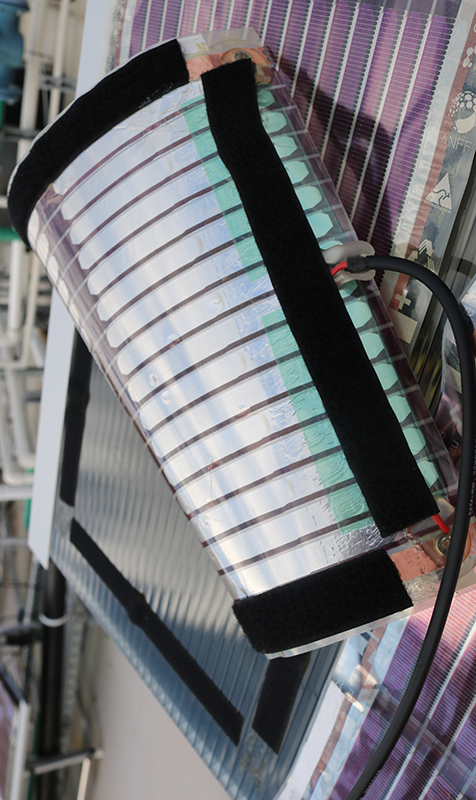Pilot printed solar site open
 Australia’s first printed solar demonstration site has opened.
Australia’s first printed solar demonstration site has opened.
Printed solar creator Professor Paul Dastoor says that at one hundred square metres in size, there are only two other comparable sites worldwide.
“There are just three demonstration sites at this scale that we know of anywhere in the world, so Australia has joined quite an elite group of global leaders poised to make this technology a commercial reality,” he said.
Professor Dastoor says the material could be rapidly manufactured, enabling accelerated deployment into the marketplace.
“No other renewable energy solution can be manufactured as quickly. On our lab-scale printer we can easily produce hundreds of metres of material per day, on a commercial-scale printer this would increase to kilometres. If you had just ten of these printers operating around the clock we could print enough material to deliver power to 1000 homes per day,” he said.
“The low-cost and speed at which this technology can be deployed is exciting, particularly in the current Australian energy context where we need to find solutions, and quickly, to reduce demand on base-load power.”
The material is made by printing an advanced electronic ink onto paper-thin, clear laminated sheets using conventional printing presses. Professor Dastoor’s team at the University of Newcastle pioneered both the electronic ink and printing process.
All of the components of these advanced electronic inks are synthesised at scale within UON’s Centre for Organic Electronics using non-toxic carbon-based materials, and are either used directly or further processed into water-based inks and paints.
Initially, the electrical output of the site is being used for scientific study - allowing Australian researchers to monitor how large areas of these unique printed solar cells respond under different real-world conditions.
Professor Dastoor said that unlike traditional PV panels, the technology maintains a more constant power flow in low-light and cloud cover.
“Our printed solar solution continues to function consistently in low light and under cloud cover, which means that users don’t experience dips in productivity.”
The material is so sensitive it can produce small quantities of energy from moonlight.
The light, thin film is attached to the roof and walls of the demonstration site by everyday Velcro strips, with the ‘roll-out’ consisting of exactly that - ’rolling out’ a long sheet of laminated material.
“The technology is low-cost and very portable making it ideal for … an estimated 1.2 billion people [who] still have no access to electricity,” Prof Dastoor said.
“Because it is light and can be printed quickly it is also ideal for disaster relief and recovery applications supporting displaced people and powering temporary emergency bases. The material can be safely airdropped and very easily installed.”
“It could be ideal for forward operating bases and special operations as it lightweight – the lightest energy generation technology by kilo that exists, and produces no noise.”
“The material could also be used as sails for yachts and on ship decks.”
The demonstration site enables final phase testing and modifications of the system before the renewable energy technology can be made available to the public.
“This installation brings us closer than we have ever been to making this technology a reality. It will help to determine the lifespan of the material and provide half-hourly feedback on the performance of the system,” said Professor Dastoor.
The technology has attracted a commercial partner, global logistics solutions company CHEP, whose spokesperson Lachlan Feggans says will work on a commercial scale pilot installation of organic printed solar on the roof of one of its service centres next financial year.
“Through our collaboration with UON, we see the potential to make CHEP’s inherently sustainable business model even better. Our aim is to develop better supply chains, but we recognise that this begins with sustainability in our own operations,” said Mr Feggans.
The technology will also be demonstrated at the major printing tradeshow Pacprint at the Melbourne Convention and Exhibition Centre in late May.







 Print
Print